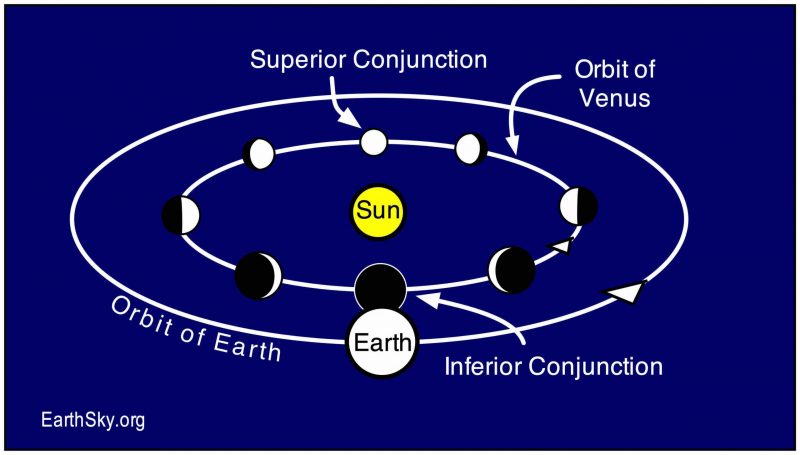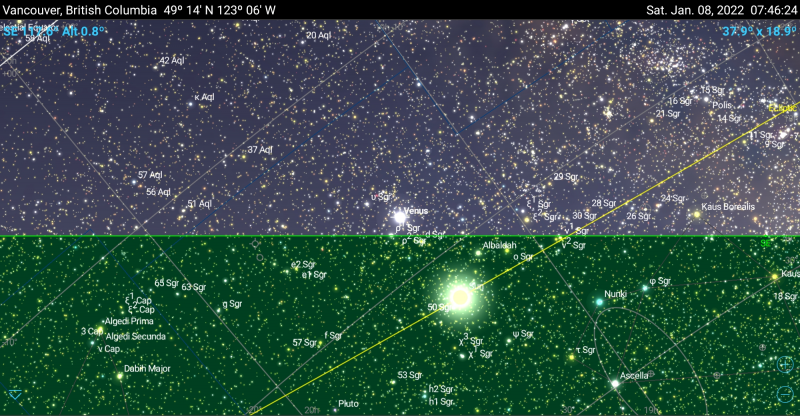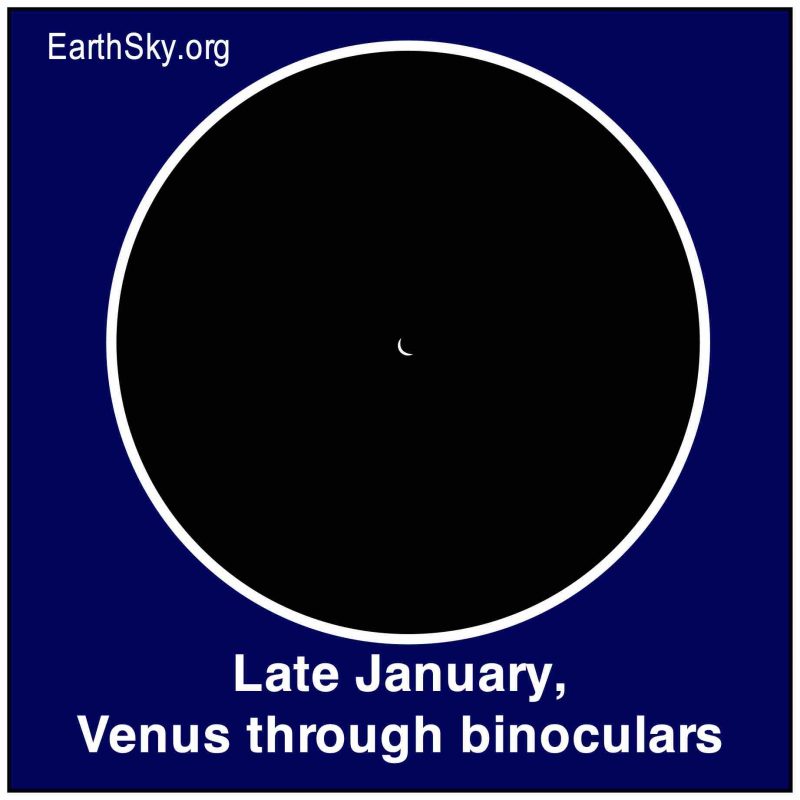
Venus in inferior conjunction
Venus travels one step inward from Earth in orbit around the sun. Its orbit is smaller than Earth’s. It has less distance to cover. And it moves faster in orbit (about 35 km/s in contrast to about 30 km/s for Earth). So Venus goes between us and the sun every so often. And, at such times, astronomers say it’s in inferior conjunction with the sun. Venus comes to inferior conjunction in 2022 at 1 UTC on January 9 (7 p.m. CST on January 8). Will you see Venus on the day of inferior conjunction? It’s not likely, unless you’re an extremely careful and experienced telescopic observer. After all, on the day of inferior conjunction, Venus will be crossing the sky with the sun during the day. More about when you’ll next see Venus below.
Venus, amidst its retrograde motion through the constellation Sagittarius, will comfortably pass north of the sun in our sky at the moment of inferior conjunction. It will pass just under 5 degrees from the sun. At the moment of inferior conjunction, Venus will officially shift from the evening to the morning sky for all observers on Earth.
Venus – our closest planetary neighbor and the brightest planet in our sky – passes between the Earth and the sun about every 19 months (1.6 years). So inferior conjunction for Venus happens that often.
The 2022 lunar calendars are here. Order yours before they’re gone!
Cycles of Venus
The 1.6-year period – after which the position of Venus relative to the sun repeats, as seen from Earth – is called its synodic period.
Notice that 5 synodic periods of Venus add up to 8 years (just two-and-a-half days short). And so we have a cycle: inferior conjunctions of Venus that are 8 years apart happen at the same time of year, in the same part of the sky, with Venus at a similar angular distance from the sun, that is, the same apparent distance from the sun on the sky’s dome. Over time, this two-and-a-half-day variance will accumulate, so that the conjunctions “jump” into the previous month.
So inferior conjunctions of Venus strongly resemble each other on an 8-year cycle.
Two recent Venus transits, in June
The last passage of Venus between us and the sun happened on June 3, 2020. It was quite dramatic. Venus appeared in our sky within “touching distance” of our star. Venus missed the solar disk in 2020 by only a quarter of a degree.
So, in 2020, Venus fell short of transiting, or crossing, the solar disk as it had done 8 years earlier, on June 5, 2012 (and also 8 years before that, on June 8, 2004).
With the conjunctions of 2004 and 2012 resulting in transits, and the one in 2020 resulting in a near-miss, one could correctly conclude that the angular distance from the sun during these (currently) June series of inferior conjunctions is slowly but steadily increasing. And so they are. The June-May inferior conjunctions of Venus will not result in any more transits for many centuries.

January transits of Venus
The inferior conjunction on January 8-9, 2022, does not carry the drama of its predecessor in June, 2020.
During the previous January inferior conjunction on January 10, 2014, Venus was around one-third of a degree farther from the sun than it is at the January 8-9, 2022, event. The next January conjunction of 2030 will fall even closer than 2022, at just 4.5 degrees. So one might assume that this January series is slowly inching (in astronomical terms) towards the sun.
And that would be a correct assumption. Venus is currently getting closer and closer to the sun on the sky’s dome at the January inferior conjunctions.
What’s more, as the conjunction of 2022 falls on the 8th day of January, the two-and-a-half day shift will cause this January series to shift into December relatively soon, in 2045. From that moment this, now-December series will result in closer and closer approaches to the sun in the second half of the century and in the early 22nd century the angular distance with the sun at the December inferior conjunction series will have decreased so much that it will bring us another pair of transits in years 2117 and 2125.
Some children alive today will likely live to see the Venus transits of the early 22nd century.

For experts, seeing Venus morning and evening
Keen observers located north of the 40 N. latitude might be able to spot Venus as both an evening star and a morning star on the same day. The best day for this interesting phenomenon is January 8, although one day before or after, this celestial geometry will be nearly as good. Of course, extreme safety precautions are the rule when attempting to observe any object so close to the sun.
Please do not attempt to observe Venus near the sun unless you’re an experienced sun observer.


When will you next see Venus?
Otherwise, you can expect to see Venus come back to the morning sky – east before sunrise, as seen from all parts of the globe – this month. Since Venus is the brightest planet, you’ll be able to spot it low in the east, near the sunrise point, not long before the sun comes up. Venus will surprise you with its brightness so low in the sky! In fact, by the end of January 2022, Venus will be heading for another greatest brilliancy in early February.
Watch for it in the last half of January!


Bottom line: Venus comes to inferior conjunction – passing between Earth and sun – in 2022 at 1 UTC on January 9 (7 p.m. CST on January 8).
Read more from Guy Ottewell: The 5 ‘petals’ of Venus and its 8-year cycle
The post Inferior conjunction – Venus between sun and Earth – January 8-9 first appeared on EarthSky.
0 Commentaires